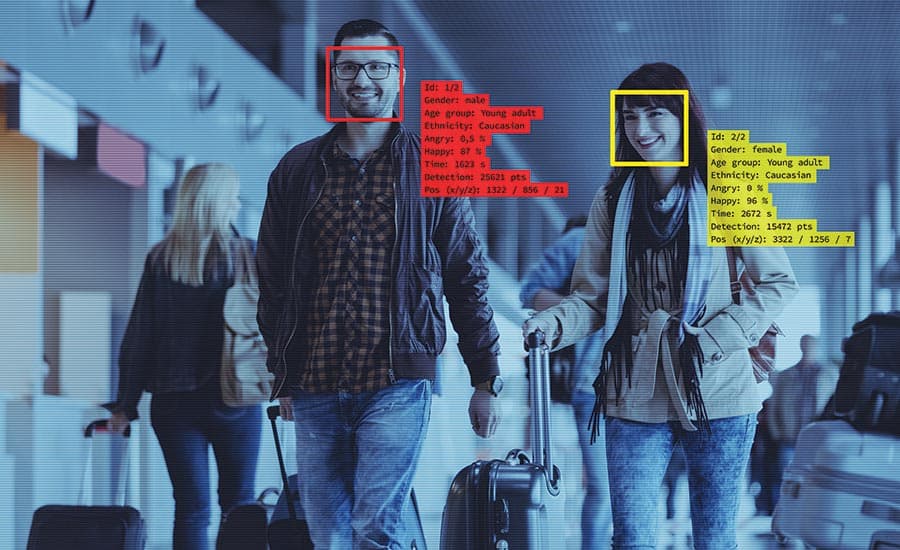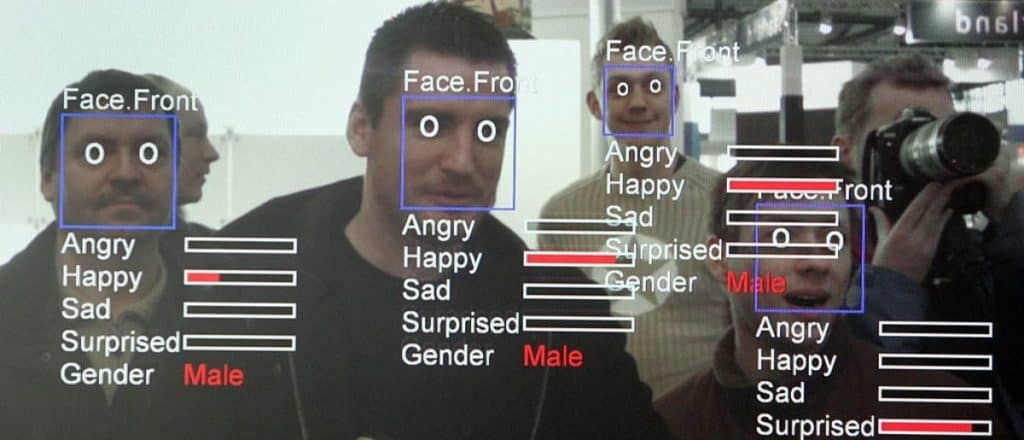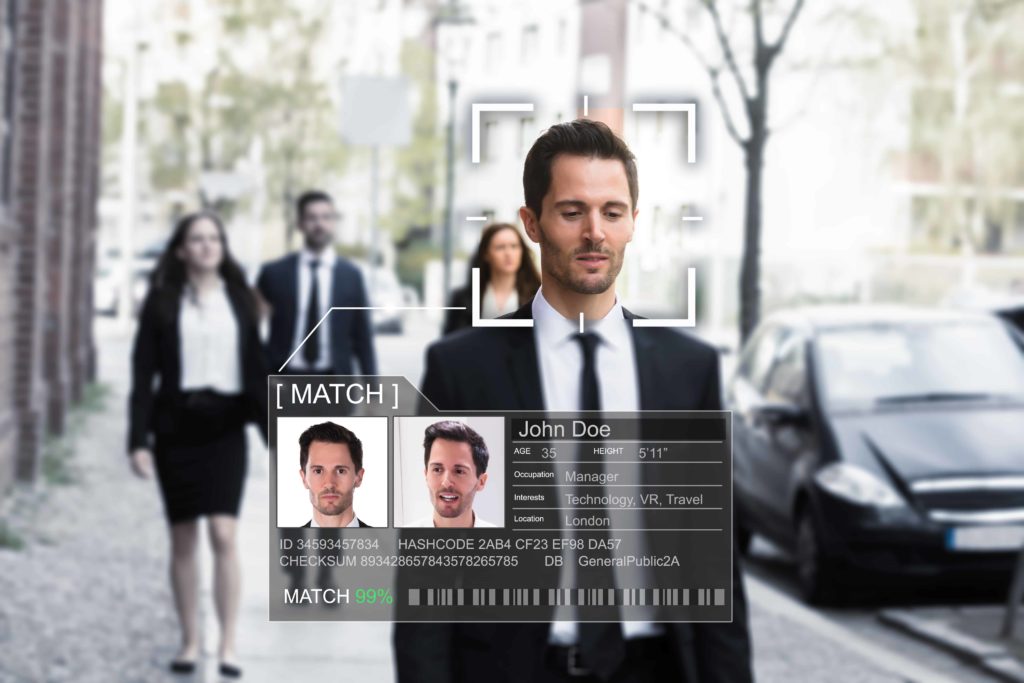Whether you’re opening your bank account on your phone, having a genetic evaluation with a doctor, or playing with silly apps like Genderswap, facial recognition is everywhere.
The technology uses certain identifying facial characteristics to do everything from serve ads, to track people. It’s used on Facebook, at airports, on bank transfers — you name it, facial recognition is likely being developed for it.
In fact, The Guardian reports that “thanks to facial recognition, billboards can now serve up ads based on an estimate of your sex, age, and mood.”

In many respects, this new era of identity technology seems like a godsend. It can increase efficiency while improving personalized messaging. But are there sinister elements at work as well? Some worry that it is a type of big brother surveillance tool that, put in the wrong hands, could be used by bad actors to do everything from racially profile people to destroy privacy.
So what is it? A tool for good or evil? Or is it something less definitive, an application that exists in the gray area where its future is at the mercy of those using it?
In this guide, we’ll look at facial recognition technology and discuss its promises and perils.
A Powerful Tool
At its best, It offers many benefits to society when used with good intentions. For instance, law enforcement has utilized facial recognition to help find missing people. In May, for example, CNN reported on how Chinese facial recognition technology helped reunite a man who was abducted 32 years ago with his mother.
Facial recognition can also protect against theft. In a bid to stop shoplifting, 700 Australian 7-11 stores rolled out facial recognition surveillance systems this year, according to The Daily Mail.
It can improve efficiency as well. Consider the speed at which people can now log in to apps like PayPal with a mere flash of their face. Rather than remembering another password, facial recognition takes the guesswork out of logging in by identifying a customer by their eyes, nose, and mouth.
And then there are the many ways it is improving medicine. Incredibly, the field of genetic disorders is seeing all kinds of breakthroughs due to facial recognition.
In 2019, The Scientist published a report that argued that facial photos of patients are now “helping identify which of multiple possible genetic mutations could be behind a person’s condition.”
And these are just a few of the ways facial recognition could be used for good in the world. The possibilities really are just a matter of human creativity.
But just as the sky’s the limit as far as good uses for facial recognition technology, this powerful tool can also be used for ill.
The Dark Side of Facial Recognition
Data theft, invasion of privacy, violation of personal rights—these are just a few of facial recognition drawbacks. And not surprisingly it’s already being corrupted.
In many countries, governments are using facial recognition as a surveillance tool. ABC News reported in April of this year that “Russia’s capital now has one of the largest facial recognition systems in the world and it is using it to police its quarantine restrictions imposed in response to the coronavirus pandemic.”
While on its surface that may sound innocuous, maybe even beneficial for the greater health of the country, some argue that being recorded without one’s knowledge infringes on personal liberties.
Facial recognition’s flaws have also been found to lead to false arrests. In June NPR reported that Detroit police incorrectly arrested a Black man, charging him with stealing five watches after running a security video through facial recognition technology. While the software has promising capabilities for law enforcement, it’s not foolproof.
It also opens the doors for scammers and fraudsters. Some have suggested that facial recognition technology could be used to harvest facial data to commit crimes. The collection of videos and images could be used to gather information on a victim or used to take out credit cards or open accounts in their name.
Good Faith Facial Recognition
All that said, the promises of facial recognition for marketers are many. And to show just how, we’re going to explore a series of real-world examples in which brands have built campaigns around the technology.
Walmart
Last year, Business News Daily says that Walmart began a campaign using facial recognition targeting thirsty customers. Embedded cameras on coolers were used to identify a shopper’s age and gender and then targeted an ad for a drink using that information.

So if a 20-something woman walked by, the ad might switch from Diet Coke to Vitamin Water. Many hailed the idea as the ultimate example of personalized marketing—a way to personalize ads in real-time.
Ford
Given the rise in computerized technology in cars, it’s no surprise that the automobile industry is at the forefront of facial recognition. CBInsights says that last year Ford teamed up with a company called Project Mobil to create a facial recognition technology within the dashboard that can recognize the primary vehicle driver. Using this tool, it can then tailor the driving experience for that individual and calibrate the settings, from the seat position to the music volume, accordingly.

17Beauty
Beijing-based cosmetics company 17Beauty has jumped on the facial recognition bandwagon by implementing the software in high-traffic beauty stands. Using a QR code, customers can log in and receive personalized makeup suggestions.
An Ethical Dilemma
Not surprisingly, policymakers are racing to create ethical frameworks for facial recognition. To encourage trust, many big tech companies have been made promises to abide by certain facial recognition rules. For example, in June of this year, Microsoft, IBM, and Amazon announced “sweeping restrictions on their sale of facial recognition tools and called for federal regulation amid protests across the United States against police violence and racial profiling,” according to ABC News.
Many state and city governments don’t see this as enough and have implemented their own regulations. Incidentally, in Washington state, a Microsoft employee actually wrote a bill, SB 6280, which was signed into law in April, that lays out the state’s facial recognition restrictions.
And these rules and regulations are something all marketers must keep in mind. The landscape of facial recognition is evolving so quickly that staying one step ahead of the restrictions is imperative to rolling out a successful facial recognition campaign.
While the possibilities of facial recognition are endless for marketers, consumers are already suggesting they’re fearful of the technology. In a CRM story in March, it reported on a study which found 80 percent very concerned about privacy invasion. To assuage this fear, marketers need to embrace a policy of transparency. That means being completely upfront with customers about what you’re doing with their data.
The aforementioned GetApp study concluded with the following: “For the technology to succeed at scale, consumers must trust that it is accurate, secure, and not needlessly invasive. Improved algorithms, responsible deployment, and practical regulation will help us realize the utility of facial recognition technology while also protecting our privacy.”
To make facial recognition work and benefit both brands and consumers, practitioners will have to build trust in every single campaign.
Curious about what else lies ahead for marketers? Read our post “6 Digital Marketing Trends That Will Dominate 2021.”




